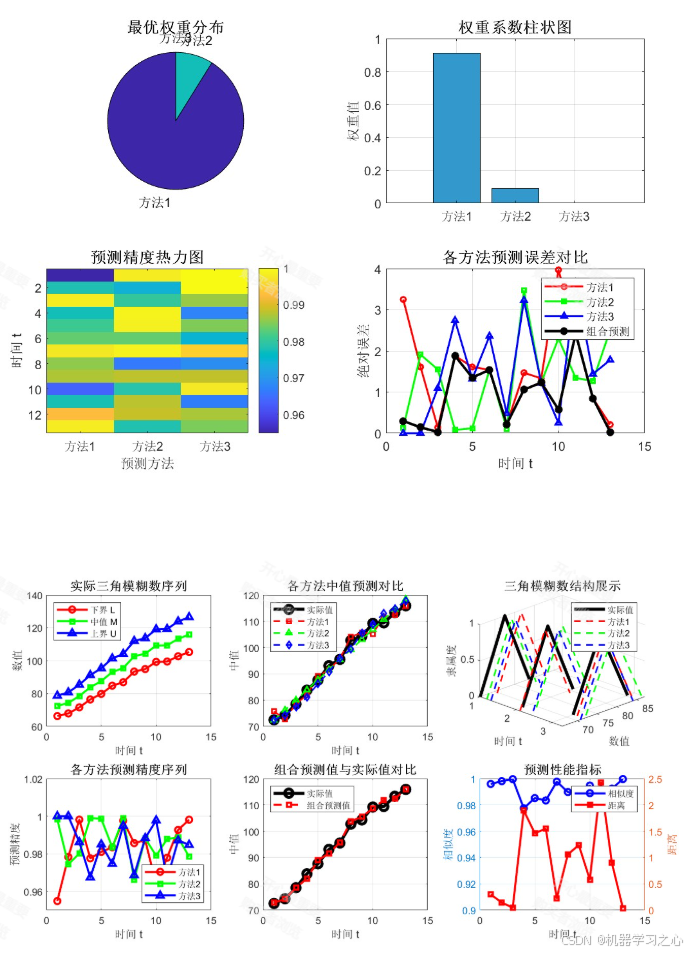
1. 基本概念与理论基础
核心概念定义
classdef PredictionConceptspropertiesfirst_order_efficiencyfuzzy_combinationendmethodsfunction obj = PredictionConcepts()fprintf('基于一阶预测有效度的IGOWLA算子模糊组合预测方法\n');endend
end
2. 数学模型构建
2.1 一阶预测有效度计算
function [efficiency, accuracy] = calculateFirstOrderEfficiency(actual, predicted, time_window)n = length(actual);efficiency = zeros(n - time_window + 1, 1);accuracy = zeros(n - time_window + 1, 1);for t = time_window:nactual_window = actual(t-time_window+1:t);predicted_window = predicted(t-time_window+1:t);relative_errors = abs(actual_window - predicted_window) ./ abs(actual_window);accuracy(t-time_window+1) = 1 - mean(relative_errors);actual_trend = diff(actual_window);predicted_trend = diff(predicted_window);trend_correlation = corr(actual_trend(:), predicted_trend(:));if isnan(trend_correlation)trend_correlation = 0;endefficiency(t-time_window+1) = accuracy(t-time_window+1) * (1 + abs(trend_correlation));end
end
2.2 IGOWLA算子实现
function aggregated_value = IGOWLA_operator(values, weights, lambda, inducing_variable)n = length(values);[sorted_inducing, sort_index] = sort(inducing_variable, 'descend');sorted_values = values(sort_index);sorted_weights = weights(sort_index);if abs(sum(sorted_weights) - 1) > 1e-10sorted_weights = sorted_weights / sum(sorted_weights);endif lambda == 0log_values = log(sorted_values);aggregated_value = exp(sum(sorted_weights .* log_values));elseweighted_powers = sorted_weights .* (sorted_values .^ lambda);aggregated_value = (sum(weighted_powers)) .^ (1/lambda);endefficiency_factor = mean(sorted_inducing(1:ceil(n/2)));aggregated_value = aggregated_value * (1 + 0.1 * (efficiency_factor - 0.5));
end
3. 模糊组合预测系统
3.1 模糊隶属度函数
function membership = fuzzy_membership(efficiency, method)switch methodcase 'gaussian'center = 0.8; sigma = 0.2; membership = exp(-(efficiency - center).^2 / (2 * sigma^2));case 'trapezoidal'a = 0.6; b = 0.7; c = 0.9; d = 1.0;if efficiency <= amembership = 0;elseif efficiency <= bmembership = (efficiency - a) / (b - a);elseif efficiency <= cmembership = 1;elseif efficiency <= dmembership = (d - efficiency) / (d - c);elsemembership = 0;endcase 'sigmoid'alpha = 10; beta = 0.7;membership = 1 ./ (1 + exp(-alpha * (efficiency - beta)));otherwiseerror('不支持的隶属函数类型');end
end
3.2 主要预测方法类
classdef FuzzyCombinationPredictionpropertiesmethodshistorical_datafirst_order_efficiencyigowla_lambdafuzzy_weightsendmethodsfunction obj = FuzzyCombinationPrediction(data, method_names)obj.historical_data = data;obj.methods = method_names;obj.igowla_lambda = 1.0; obj = obj.initializeWeights();endfunction obj = initializeWeights(obj)n_methods = length(obj.methods);obj.fuzzy_weights = ones(1, n_methods) / n_methods;obj.first_order_efficiency = zeros(1, n_methods);endfunction [combined_forecast, individual_forecasts] = predict(obj, new_data_point)individual_forecasts = obj.getIndividualForecasts(new_data_point);obj = obj.updateEfficiency(individual_forecasts, new_data_point);obj = obj.updateFuzzyWeights();combined_forecast = obj.applyIGOWLA(individual_forecasts);endfunction forecasts = getIndividualForecasts(obj, data_point)n_methods = length(obj.methods);forecasts = zeros(1, n_methods);for i = 1:n_methodsswitch obj.methods{i}case 'ARIMA'forecasts(i) = obj.arimaForecast(data_point);case 'NeuralNetwork'forecasts(i) = obj.nnForecast(data_point);case 'ExponentialSmoothing'forecasts(i) = obj.esForecast(data_point);case 'SVM'forecasts(i) = obj.svmForecast(data_point);otherwiseforecasts(i) = data_point * (0.95 + 0.1 * rand());endendendfunction obj = updateEfficiency(obj, forecasts, actual)n_methods = length(obj.methods);for i = 1:n_methodserror = abs(forecasts(i) - actual) / abs(actual);alpha = 0.1; new_efficiency = 1 - error;obj.first_order_efficiency(i) = alpha * new_efficiency + ...(1 - alpha) * obj.first_order_efficiency(i);endendfunction obj = updateFuzzyWeights(obj)n_methods = length(obj.methods);new_weights = zeros(1, n_methods);for i = 1:n_methodsmembership = fuzzy_membership(obj.first_order_efficiency(i), 'sigmoid');new_weights(i) = membership;endif sum(new_weights) > 0obj.fuzzy_weights = new_weights / sum(new_weights);elseobj.fuzzy_weights = ones(1, n_methods) / n_methods;endendfunction combined_value = applyIGOWLA(obj, forecasts)combined_value = IGOWLA_operator(...forecasts, ...obj.fuzzy_weights, ...obj.igowla_lambda, ...obj.first_order_efficiency);endend
end
4. 完整的预测系统实现
4.1 主控制系统
classdef PredictionSystempropertiescombination_modelperformance_metricsprediction_historyendmethodsfunction obj = PredictionSystem(historical_data)method_names = {'ARIMA', 'NeuralNetwork', 'ExponentialSmoothing', 'SVM'};obj.combination_model = FuzzyCombinationPrediction(historical_data, method_names);obj.performance_metrics = struct();obj.prediction_history = [];endfunction obj = runPrediction(obj, test_data)n_test = length(test_data);predictions = zeros(n_test, 1);actual_values = zeros(n_test, 1);fprintf('开始基于IGOWLA算子的模糊组合预测...\n');for t = 1:n_testcurrent_point = test_data(t);actual_values(t) = current_point;[combined_pred, individual_preds] = obj.combination_model.predict(current_point);predictions(t) = combined_pred;obj.prediction_history(t).time = t;obj.prediction_history(t).actual = current_point;obj.prediction_history(t).combined = combined_pred;obj.prediction_history(t).individual = individual_preds;obj.prediction_history(t).weights = obj.combination_model.fuzzy_weights;obj.prediction_history(t).efficiency = obj.combination_model.first_order_efficiency;if mod(t, 10) == 0fprintf('已完成 %d/%d 个预测点\n', t, n_test);endendobj = obj.calculatePerformanceMetrics(actual_values, predictions);endfunction obj = calculatePerformanceMetrics(obj, actual, predicted)errors = actual - predicted;obj.performance_metrics.MAE = mean(abs(errors));obj.performance_metrics.MSE = mean(errors.^2);obj.performance_metrics.RMSE = sqrt(mean(errors.^2));obj.performance_metrics.MAPE = mean(abs(errors ./ actual)) * 100;obj.performance_metrics.R2 = 1 - sum(errors.^2) / sum((actual - mean(actual)).^2);endfunction plotResults(obj)figure('Position', [100, 100, 1400, 900]);subplot(2, 3, 1);actual = [obj.prediction_history.actual];combined = [obj.prediction_history.combined];plot(actual, 'b-', 'LineWidth', 2, 'DisplayName', '实际值');hold on;plot(combined, 'r--', 'LineWidth', 2, 'DisplayName', '组合预测值');title('预测值与实际值对比');xlabel('时间');ylabel('值');legend;grid on;subplot(2, 3, 2);errors = actual - combined;plot(errors, 'g-', 'LineWidth', 1.5);title('预测误差');xlabel('时间');ylabel('误差');grid on;subplot(2, 3, 3);weights_history = vertcat(obj.prediction_history.weights);plot(weights_history, 'LineWidth', 1.5);title('模糊权重演化');xlabel('时间');ylabel('权重');legend(obj.combination_model.methods, 'Location', 'best');grid on;subplot(2, 3, 4);efficiency_history = vertcat(obj.prediction_history.efficiency);plot(efficiency_history, 'LineWidth', 1.5);title('一阶预测有效度演化');xlabel('时间');ylabel('有效度');legend(obj.combination_model.methods, 'Location', 'best');grid on;subplot(2, 3, 5);metrics = struct2cell(obj.performance_metrics);metric_names = fieldnames(obj.performance_metrics);bar(cell2mat(metrics));set(gca, 'XTickLabel', metric_names, 'XTickLabelRotation', 45);title('预测性能指标');ylabel('值');grid on;subplot(2, 3, 6);histogram(errors, 20, 'Normalization', 'probability');title('预测误差分布');xlabel('误差');ylabel('概率');grid on;endend
end
5. 应用示例
5.1 债券收益率预测示例
function bondYieldPredictionExample()rng(42); n_points = 200;time = (1:n_points)';trend = 0.02 + 0.001 * time;seasonal = 0.01 * sin(2 * pi * time / 50);noise = 0.005 * randn(n_points, 1);bond_yields = trend + seasonal + noise;train_ratio = 0.7;n_train = floor(train_ratio * n_points);train_data = bond_yields(1:n_train);test_data = bond_yields(n_train+1:end);prediction_system = PredictionSystem(train_data);prediction_system = prediction_system.runPrediction(test_data);fprintf('\n=== 预测性能结果 ===\n');metrics = prediction_system.performance_metrics;fprintf('MAE: %.6f\n', metrics.MAE);fprintf('RMSE: %.6f\n', metrics.RMSE);fprintf('MAPE: %.4f%%\n', metrics.MAPE);fprintf('R²: %.4f\n', metrics.R2);prediction_system.plotResults();fprintf('\n最终模糊权重:\n');for i = 1:length(prediction_system.combination_model.methods)fprintf('%s: %.4f\n', ...prediction_system.combination_model.methods{i}, ...prediction_system.combination_model.fuzzy_weights(i));end
end
bondYieldPredictionExample();
6. 方法优势分析
主要优势
- 自适应权重调整:基于一阶预测有效度动态调整各方法权重
- 不确定性处理:模糊逻辑有效处理预测不确定性
- 非线性聚合:IGOWLA算子提供灵活的信息聚合方式
- 趋势敏感性:一阶有效度关注预测的趋势一致性
适用场景
- 金融时间序列预测
- 经济指标预测
- 市场需求预测
- 任何需要组合多个预测模型的场景

